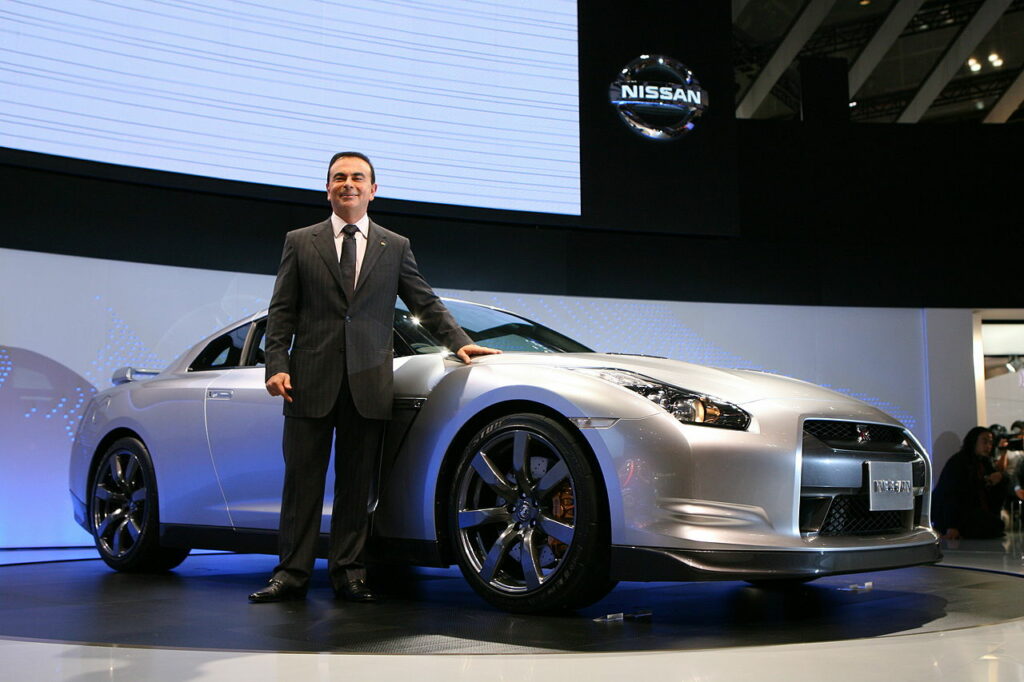
In engineering the arrest of Carlos Ghosn, the executives at Nissan displayed their nation’s barbarous judicial system and their company’s self-destructive management for the entire world to see. It is not a pretty picture. But it certainly is a revealing one. Japan tortures Ghosn, and the world is watching.
Nissan, Renault, and Mitsubishi together form an “alliance,” an agreement for collaboration between the three independent companies. Ghosn, the chief executive officer of both Nissan and Renault, wanted a merger of the companies. Renault owns 43% of Nisssan, and this gave Ghosn the votes to get what he wanted. Nissan’s management opposed that plan – and plotted to have Ghosn arrested by Japanese prosecutors and held in solitary confinement to stop him.
It is said that nations, like individuals, have an inherent character that inevitably guides their actions. If so, the effective kidnapping of Carlos Ghosn by Japanese prosecutors at the behest of Nissan executives reveals more about Japan’s character than Japan apparently wants the world to see. The recent granting of bail to Ghosn, an action almost unprecedented in the Japanese judicial system, shows that Japan has noticed the damage it has done to its national image. But, belatedly granting bail to Ghosn does not change the system of criminal “justice” Japan employs, or the fundamental flaws in its national character that made possible the arrest and incarceration of Ghosn in solitary confinement. Ghosn’s incarceration highlights a society that allows use of mental torture of criminal suspects to extract confessions and then justifies conviction because the accused confessed.
Civilized societies do not do that.
It also doesn’t help Nissan.
For Nissan, this is history repeating itself – a history that previously resulted in Nissan almost going bankrupt, only to be saved by Carlos Ghosn.
NISSAN’S CHARACTER FLAW
Since the founding of the United States as a constitutional society, coerced confessions have been considered violations of fundamental Constitutional rights. The Fifth and Fourteenth Amendments prohibit use of a coerced confession in evidence at a criminal trial; the Eight and Fourteenth Amendments give the accused the right to “reasonable bail.” Why are coerced confessions inadmissible? It is not merely because coercing them is unfair, though it is. The primary reason a coerced confession is inadmissible is because it is unreliable. When you coerce a confession, you overcome the individual’s will to resist. That means the individual will say what you want him to say. A society that tolerates coercing confessions is not merely unfair. It is a society that has no interest in the truth. It is interested only in the unfettered exercise of power.
The executives at Nissan engineering the arrest of Ghosn had every reason to view him as a direct threat to their power over the company. These are, after all, the executives responsible for Nissan’s recent scandals: safety and emissions standards violations that implicated Nissan’s highest levels of domestic management in corporate wrongdoing. In September of 2018, only three months before Ghosn’s arrest, Nissan blamed decades of cheating on emissions and fuel economy standards. Nissan’s official company statement explained that “[a]s a company – executives, manager to plant supervisors – Nissan had extremely low awareness of the gravity of violating . . . standards and rules.” Notice that the statement does not claim these Nissan executives were ignorant of the rules. It merely claims they didn’t think violating them was a big deal. A year before that scandal surfaced, Nissan admitted another standards scandal involving uncertified inspectors. The company had been doing it, and concealing it, for decades. Apparently, that scandal had not been enough to give Nissan executives, managers, and plant supervisors heightened “awareness” that rules really are meant to be followed.
NISSAN AND THE KEIRETSU

Carlos Ghosn was chairman of Nissan during these periods, but plainly not the man responsible for operating the company. That man was Chief Executive Officer, Hiroto Saikawa. Saikawa, however, had publicly stated his complete opposition to Ghosn’s plan to merge Renault, owner of 43% of Nissan’s voting stock, into a combined company. He opposed Ghosn’s plans to focus Nissan more directly on the United States market, rather than the Japanese market. He was also about to be fired. After Ghosn’s arrest, insiders reported that Ghosn intended to ask the Nissan Board of Directors at their November meeting to dismiss Saikawa, citing as reasons the safety and emission scandals and poor sales in the United States. With 43% of the shares (and France, which owns a substantial block of Renault shares) behind him, Ghosn had the control needed to win that vote.
What Ghosn did not consider was the extent to which Japan has not changed since it lost World War Two.
Prior to World War Two, Japan’s industrial and banking industries were highly integrated. It was common for companies to have large ownership interests in other companies, even competitors, and for those companies to own large percentages of each other’s shares. The structure of these companies, termed “zaibatsu,” created integrated conglomerates with enormous control over Japanese government and society, including the military. Four companies were considered in the first tier of zaibatsu. Mitsubishi was in the first tier of zaibatsu. Nissan was one of eight smaller companies considered second-tier zaibatsu.
The zaibatsu were an involved and essential component of the Japanese military aggression before and during World War Two. After Japan’s surrender, American occupation forces planned to dissolve most of the zaibatsu companies, including Nissan. Those plans, however, were abandoned. Breaking up Japan’s interlocked industries became secondary to reinvigorating the Japanese economy to keep Japan from falling under the Communist influence overtaking China, Korea, and Southeast Asia. Nissan emerged intact.
In the following years, Japanese industrial society reformed into alliances and cross-holdings that renewed the same type of closed integration of corporate ownership that existed before the War. Called “keiretsu,” these were centered around the financial institutions that had been the banking components of the zaibatsu. The keiretsu companies, like the zaibatsu companies, are marked by interlocked shareholding. The interlocked ownership leads to interlocking boards that have the same individuals serving on boards of several companies with the keiretsu.
This is a structure designed to concentrate control. It is also a structure designed to keep outsiders out – a design no different than it was when the zaibatsu controlled Japanese industry.
NISSAN REPEATS ITS FAILED HISTORY
The 43% ownership of Nissan by Renault, the product of Nissan’s serious financial problems in the 1990s that had the company $22 billion in debt and verging on bankruptcy by the time Renault rescued it in 1999, makes Nissan a very rare exception to the typical keiretsu interlocking ownership that assures vested Japanese industrial and banking interests effective control of the keiretsu companies. The reality for Nissan is that a company whose name translates as “made in Japan” is controlled by Renault. Being controlled by Renault meant being controlled by Carlos Ghosn. That control was accepted when the price was saving the company. It was no longer acceptable when Nissan executives saw Nissan on its way to being subsumed into a larger entity, one that would be beyond control of the Japanese interests that effectively control all large Japanese industrial and banking enterprises.

According to the Wall Street Journal, a few months before Ghosn’s arrest executives at Nissan asked the Japanese Ministry of Economy, Trade, and Industry to intervene, to prevent merger with Renault. The ministry had agreed to intervene but wanted more say in negotiations than Nissan’s executives would cede to it.
Nissan executives decided to pursue a different approach.
We now know how that turned out.
Published reports suggest that Ghosn’s chances for acquittal are vastly improved by his release on bail. That, of course, really says little about the merits of the case, since the typical practice in Japan is to convict everyone accused by incarcerating them in solitary confinement until they confess. Ghosn remains a board member of Nissan – though not allowed to attend board meetings by the Japanese court. With Nissan executives having so directly confronted Renault with outright rebellion, Renault and Nissan recently announced a new oversight board that will, they say, govern by “consensus.” While that approach epitomizes the keiretsu approach to business, the structure seems mostly designed to paper over the public schism between Nissan and Renault. If Renault really is ceding Nissan management veto power, then it is conceding to a management that has a history of dishonesty and failure. If Renault continues as the dominant partner, then the coup engineered against Ghosn will be only the first shot in a war Nissan cannot afford to win.
Nissan will need exactly what Carlos Ghosn intended to provide through a merger with Renault if it is ultimately to survive the challenges facing the automobile industry in the next two decades. To compete in the global market against truly large automotive manufacturers, it will need the scale merging with Renault would provide. None of this is news. For several years before his death, the late Sergio Marchione of Fiat Chrysler had been warning that smaller automobile manufacturers, including Fiat Chrysler, would need to merge with larger companies to survive. He was not looking at next year, but he was looking at the next decade and the decade after that. He perceived a level of future investment that only the largest global automotive manufacturers would be able to afford.
For Nissan, this is history repeating itself. As in the 1990’s, Nissan is facing the future with unimaginative vehicles, diminishing market share in the United States, and ingrown management.
Nissan remains independent of Renault.
But, without Ghosn, who will rescue it this time?
For more details about the inhumane and uncivilized system of Japanese “hostage justice,” visit Human Rights Watch.


